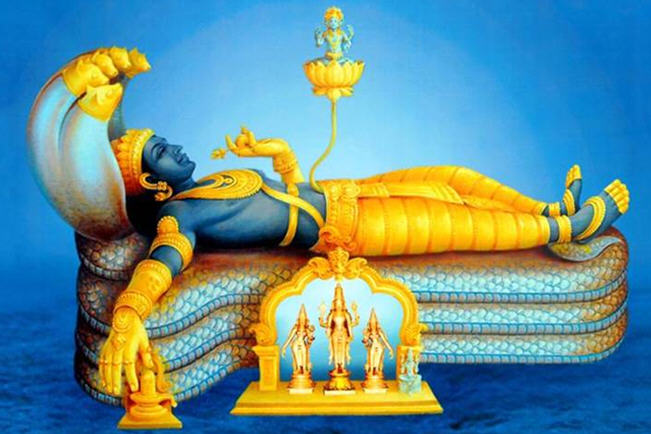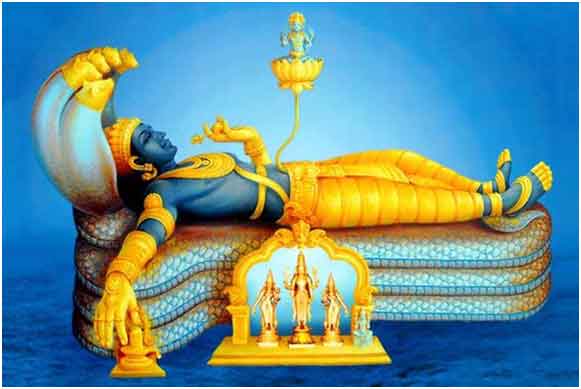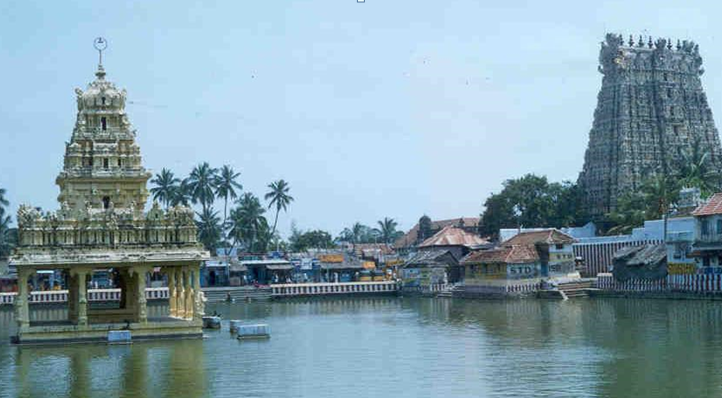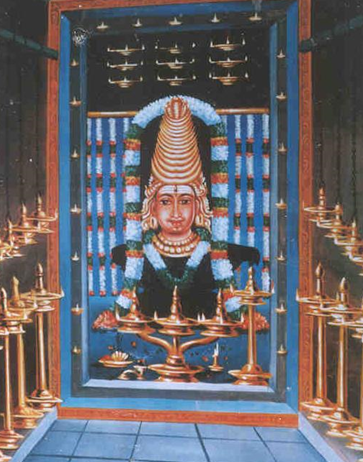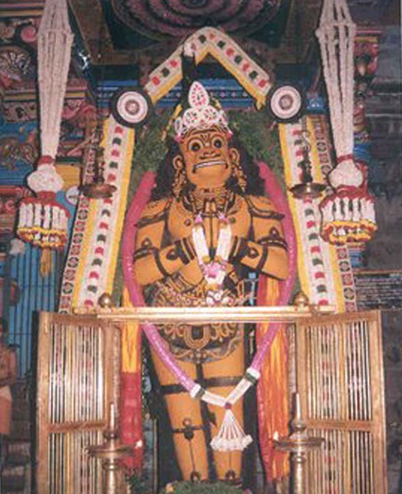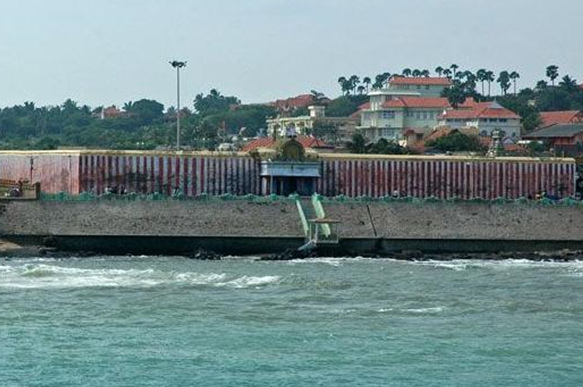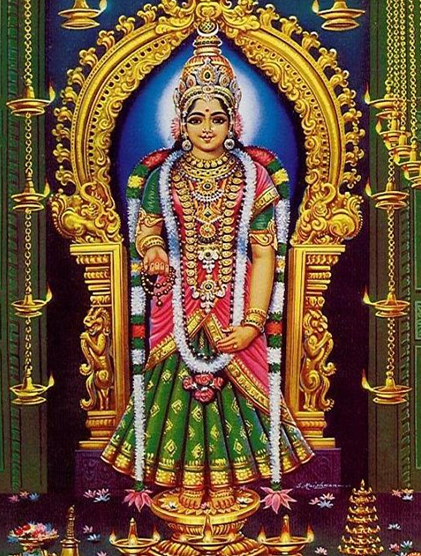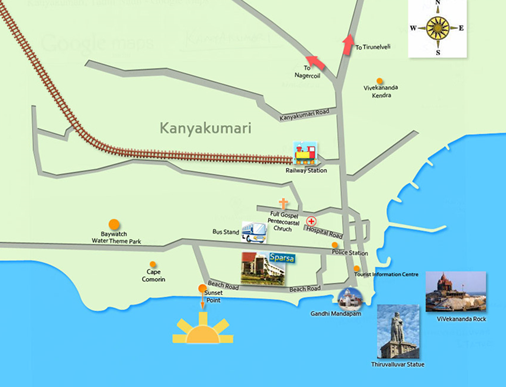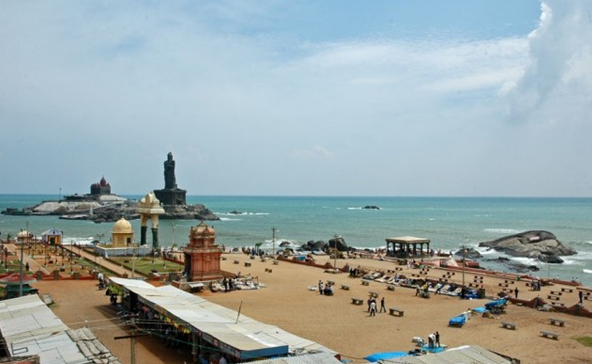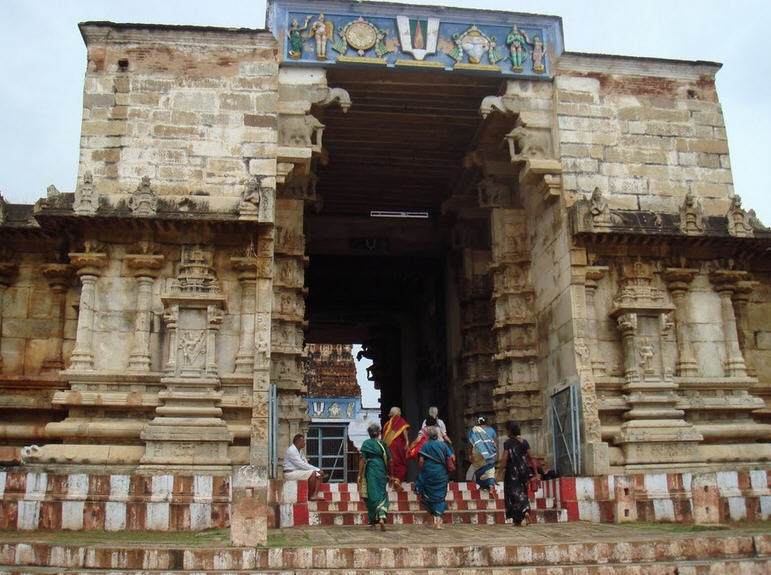
• Thirukurungudi is located about 40 kms from Tirunelveli (and about 15 kms from Nanguneri) off the Nagercoil highway at the foot of the Mahendra hill.
• At Badrinath, Lord Narayana instructed Sripada Ramanujacarya. Here, at Thirukurungudi, He took the role of a disciple and obtained Vaisnava initiation from Ramanuja. Hence, the Lord here is called vaisnava-nambi (disciple).
• Thirukurungudi is also known as Kuranga-ksetram. Kuranga is the name of Bhumi Devi (Earth) who performed penance for the Lord in this holy place. This is considered to be amongst 108 divya-desams to be visited by Sri Vaisnavas.
Pastime :
It is said that Ramanujacarya came here and prayed to the Lord. The Supreme Lord in His Deity form asked Ramanujacarya about his secret in successfully preaching Vaishnavism. He also asked about the mantra that he taught which got him such a high success rate. Understanding the Lord’s mood, Sripada Ramanujacarya replied to the Lord that the mantra can only be given to someone when one agrees to become a disciple and subordinates himself. Immediately, the Lord took the form of a young boy and became a disciple of His own devotee. Thus, the Deity here is also called vaisnava-nambi (meaning “disciple” or “small”). The Sri Vaisnava acaryas mention that the mountain ranges behind this temple are the famous Mahendra mountain, mentioned in Ramayana, wherefrom Hanuman leapt across the ocean to search for Sita Devi in Lanka.
Another importance about this temple is about its connection to one of the Alvars. It was here at this temple that a Vaisnava couple, Kari and Udayanangai, got a benediction to have a divine personality as their son. This personality was later famous as Sri Namma Alvar, one of the foremost Alvars. The place of his appearance, Thiru Alvar Nagari, located at Tirunelveli, is about a 1-hour ride from this place.
Ramanuja, during his stay at Thirukurungudi, made trips to other divya-desams such as Thiruvattar (Adikesava temple), Thiruvan Parisaram and also Ananta Padmanabhasvamy temple in Thiruvananthapuram.
At Thiruvananthapuram, Ramanujacarya got delayed, and the Lord asked Garuda to carry Ramanujacarya back to Thirukurungudi the same night. To Ramanuja’s utter surprise, he was on top of a rock at Thirukurungudi in the blink of an eye. It is said that this is the reason that we do not find Garuda in the Ananta Padmanabhasvamy temple in Thiruvananthapuram. Thirumangai Alvar, who built the huge walls of Srirangam was directed by the Supreme Lord Ranganatha to visit this place. Thirumangai composed the last of his Pasurams (bhajanas) here at this temple and is believed to have returned to His Lord from here.
Thirukurungudi and Kaisika Ekadasi
Just as Srirangam is known for its celebration of Vaikuntha Ekadasi, Thirukurungudi is famous for its celebration of Kaisika Ekadasi. This occasion is celebrated in the Tamil month of Karthigai (Kartika) and precedes Vaikuntha Ekadasi. It is believed that those who undertake fasting and singing and/or listening to the Kaisika Puranam on the Kaisika Ekadasi day will attain to Vaikuntha to serve their Lord.
THE STORY OF KAISIKA PURANAM Kaisika Puranam is the story of the great devotee Nampaduvan, a low-caste by birth and his love for Thirukurungudi Nambi. Embarrassed to enter the temple during the day as he belonged to a lower caste, he would walk several miles in the night to the Thirukurungudi Nambi temple and would, for hours together, stand before Lord with a vina (stringed instrument) and sing praises of the Lord. To ensure that no one took notice of his presence, Nampaduvan would return to his place before daylight. One night, on his way to the temple, Nampaduvan was stopped by a brahma-raksasa (a ferocious, man-eating demon) who wanted to consume Nampaduvan for dinner.
Unable to convince the demon that he would return after visiting Lord Nambi one last time, Nampaduvan related the essence of satya-sankalpam (power of fulfilling one’s promise) to the Raksasa. He told him, “The world was created through satya-sankalpam of the Lord and continues to exist as a result of the promises.” He mentions that the world experiences peace only because of the Lord’s satya-sankalpam.
Essence Kaisika Puranam
Nampaduvan makes 18 promises that night to the Raksasa and states that if he fails even in one of those 18 promises, he will be a party to 18 sins. The 18th promise of Nampaduvan is the essence of the Kaisika Puranam.
Nampaduvan says that the sin of anyone trying to equate Lord Narayana to anyone else in this world is the greatest and that he will be a party to that sin if he did not come back to the demon after meeting the Lord. If Nampaduvan does that then he will never get liberation from this cycle of birth and death. This promise convinced the Raksasa that Nampaduvan would return and he let him go. Nampaduvan spent the entire night at the Thirukurungudi Nambi temple and then made his way back to the Raksasa as promised.
As Nampaduvan is returning to the Raksasa, the Lord disguised Himself as an old brahmana and stopped Nampaduvan and asked him the reason for rushing back quick, much in contrast to his usually slow and thoughtful walk. Nampaduvan explains his situation to the brahmana, who condemns him as a fool and offers protection from the Raksasa. Nampaduvan rejects this offer stating his promise to return as quickly as possible. He informs the Brahmin that he will not hesitate to give up his own life if he has to but he will never go back on his word. He gave the demon a promise and he has to fulfill it. He has to go back to the Raksasa and become his meal.
By the Lord’s grace, the Raksasa changed his mind by the time Nampaduvan reached the spot and he no longer wanted to feast on Nampaduvan. Sri Vaisnava acaryas mention that the change was due to small fraction of association with the great devotee Nampaduvan. It is said in the scriptures, lava-matra sadhu-sange sarva-siddhi haya. With a completely changed mind, the Raksasa now asked for the fruits of all the praise that Nampaduvan had sung in glorification of the Lord Thirukurungudi Nambi during his visits to the temple every night. As an act of mercy, Nampaduvan shared with the Raksasa the Kaisika Puranam—the songs which he had sung that very night in front of Lord Nambi of Thirukurungudi. Thus, Nampaduvan helped secure entry into Vaikuntha for the Raksasa. It is believed that anyone who recites/reads or listens to the Kaisika Puranam will attain Vaikuntha within this very life.
Darshan
The Lord here is in three separate shrines, standing in one, seated in another and reclining on the third. Bhumi Devi is in a mellow green to depict the greenery of the earth, Sri Devi is in a golden yellow. True to His name of Sundara-paripurnam or Vadivalhagiya Nambi (the One with matchless beauty), the Lord here is of breath-taking beauty. Flanked by other great sages on either side of the Lord are sages like Bhrgu and Markandeya.
Other Details:
Temple Timing: 8 am-12 noon and 5 pm-9 pm
